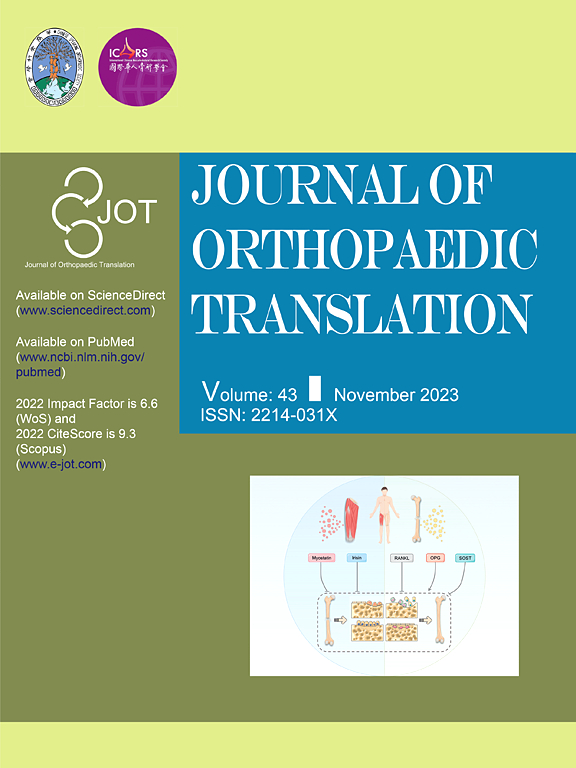A novel application perspective of the clinical-used drug verapamil on osteoporosis via targeting Txnip
IF 5.9
1区 医学
Q1 ORTHOPEDICS
引用次数: 0
Abstract
Background
RANKL and SCLEROSTIN antibodies have provided a strong effective choice for treating osteoporosis in the past years, which suggested novel molecular target identification and therapeutic strategies development are important for the treatment of osteoporosis. The therapeutic effect of verapamil, a drug previously used for cardiovascular diseases, on diabetes was due to the inhibition of TXNIP expression, which has also been reported as a target in mice osteoporosis. Whether verapamil-inhibited TXNIP expression is related to osteoporosis and how it works on the molecular level is worthy to be explored.
Methods
The polymorphism genotyping analysis was performed on patients with different degrees of osteoporosis. The responsiveness of bone marrow-derived macrophage cells (bone marrow-derived mesenchymal stem cells) to verapamil was evaluated by CCK-8, TRAP staining assay (ALP and AR staining assay), Bone Resorption Assay, and RNA-Sequencing. The expression and cytoplasmic efflux of ChREBP were determined by western blotting and immunofluorescence. Bilateral ovariectomy models were created, rescued by verapamil injection and the effectiveness was evaluated by Micro-CT and Histological analysis.
Results
Here we discovered that rs7211 single nucleotide polymorphism (SNP) of TXNIP is closely associated with increased femur neck bone mineral density (BMD) and decreased osteoporosis rate, suggesting the importance of TXNIP in the development of osteoporosis. Verapamil suppresses Txnip expression, reduces bone turnover rate and thus rescues ovariectomy-induced mice bone loss. Mechanistically, verapamil promoted ChREBP cytoplasmic efflux, regulated Pparγ expression both mediating Txnip-MAPK, NF- B axis in osteoclasts, and suppressed the ChREBP-Txnip-Bmp2 axis in osteoblasts.
Conclusions
The results of our study show the correlation of rs7211 TXNIP-T allele with Chinese increased femur neck BMD and decreased osteoporosis rate. In addition, verapamil can rescue mice from osteoporosis by regulateing ChREBP, Pparγ-Txnip-MAPK, NF- B axis in osteoclasts and ChREBP-Txnip-Bmp2 axis in osteoblasts.
The translational potential of this article
The inhibition of Txnip by verapamil in osteoclasts and osteoblasts leads to low bone turnover and reduced bilateral ovariectomy-induced mice bone loss, which points out its great clinical translation potential on postmenopausal osteoporosis treatment.

临床用药维拉帕米靶向Txnip治疗骨质疏松的新应用前景。
背景:近年来,RANKL和SCLEROSTIN抗体为治疗骨质疏松症提供了强有力的有效选择,提示新的分子靶点鉴定和治疗策略的制定对骨质疏松症的治疗具有重要意义。维拉帕米是一种以前用于心血管疾病的药物,它对糖尿病的治疗作用是由于抑制TXNIP的表达,TXNIP也被报道为小鼠骨质疏松症的靶点。维拉帕米抑制TXNIP表达是否与骨质疏松有关,其在分子水平上的作用机制值得探讨。方法:对不同程度骨质疏松患者进行多态性基因分型分析。通过CCK-8、TRAP染色法(ALP和AR染色法)、骨吸收法和rna测序评估骨髓源性巨噬细胞(骨髓源性间充质干细胞)对维拉帕米的反应性。western blotting和免疫荧光法检测ChREBP的表达和胞浆外排。建立双侧卵巢切除模型,维拉帕米注射剂挽救,显微ct和组织学分析评价效果。结果:我们发现TXNIP的rs7211单核苷酸多态性(SNP)与股骨颈骨密度(BMD)升高和骨质疏松症发生率降低密切相关,提示TXNIP在骨质疏松症发生中的重要作用。维拉帕米抑制Txnip表达,降低骨周转率,从而挽救卵巢切除小鼠骨质丢失。在机制上,异拉帕米促进ChREBP细胞质外排,调节破骨细胞中介导Txnip-MAPK、NF- κ B轴的Pparγ表达,抑制成骨细胞中ChREBP- txnip - bmp2轴的表达。结论:我们的研究结果表明rs7211 TXNIP-T等位基因与中国人股骨颈骨密度升高和骨质疏松率降低相关。此外,异拉帕米可通过调节破骨细胞的ChREBP、Pparγ-Txnip-MAPK、NF- κ B轴和成骨细胞的ChREBP- txnip - bmp2轴来挽救小鼠骨质疏松。本文的转化潜力:维拉帕米抑制Txnip对破骨细胞和成骨细胞的抑制作用降低了骨转换,减少了双侧卵巢切除引起的小鼠骨质流失,表明Txnip在绝经后骨质疏松症治疗方面具有很大的临床转化潜力。
本文章由计算机程序翻译,如有差异,请以英文原文为准。
求助全文
约1分钟内获得全文
求助全文
来源期刊

Journal of Orthopaedic Translation
Medicine-Orthopedics and Sports Medicine
CiteScore
11.80
自引率
13.60%
发文量
91
审稿时长
29 days
期刊介绍:
The Journal of Orthopaedic Translation (JOT) is the official peer-reviewed, open access journal of the Chinese Speaking Orthopaedic Society (CSOS) and the International Chinese Musculoskeletal Research Society (ICMRS). It is published quarterly, in January, April, July and October, by Elsevier.
 求助内容:
求助内容: 应助结果提醒方式:
应助结果提醒方式:


